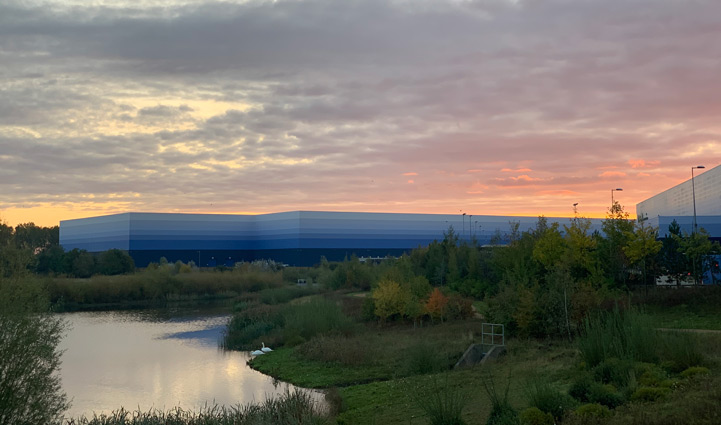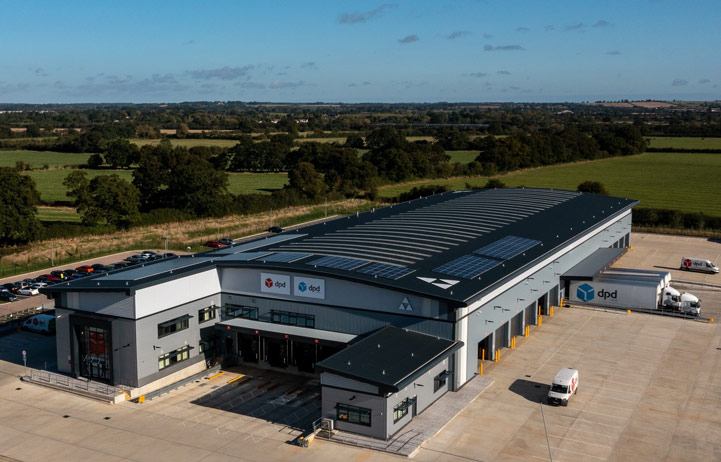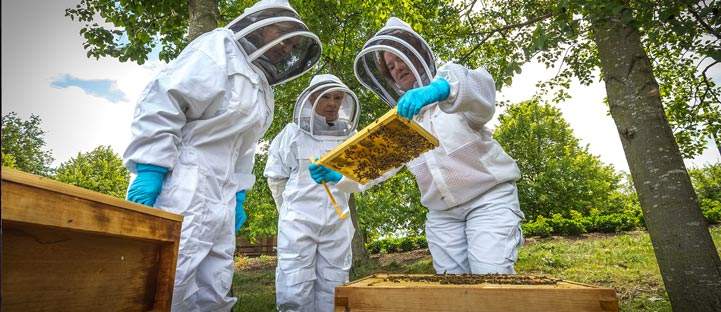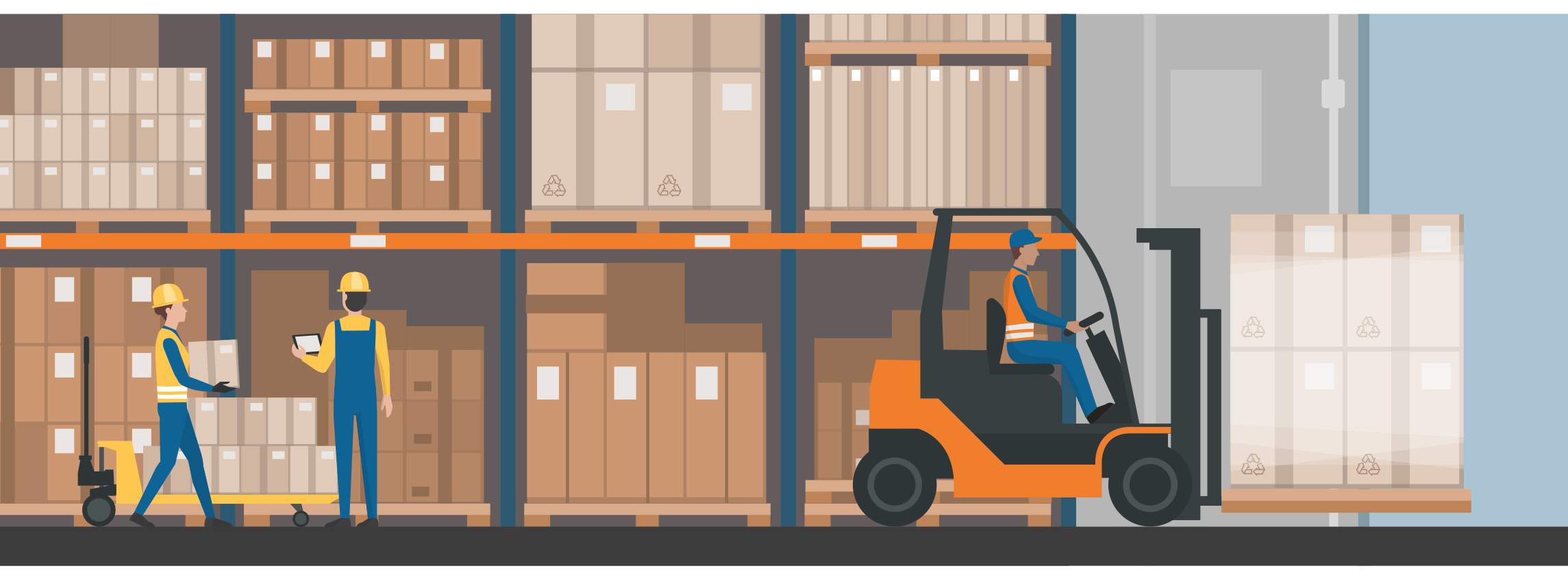To reduce carbon emissions, interventions have to be made in the construction, operation and demolition of buildings. This is leading to innovations across all phases of an I&L property’s life cycle
The Green Evolution of I&L Premises
In 2019, the UK Government and the devolved administrations committed to bring all greenhouse gas emissions to net zero by 2050, in line with recommendations made by the Committee on Climate Change. However, the Government has subsequently clarified this includes shipping and aviation emissions, which means that the rest of the economy needs to decarbonise much sooner, effectively by the very early 2030s. Reaching net zero greenhouse gas emissions requires extensive changes across the economy, and real estate has a key role to play. Every building has embodied, operational and end of life carbon emissions and the built environment contributes 40% of the UK’s carbon footprint.
This drive to lower emissions is pushing companies to take a close look at the real estate they occupy to make sure it is in line with Government carbon reduction policies. This is driving a range of innovative solutions that improve the environmental performance of I&L buildings. A Savills survey of logistics occupiers found that ‘green/sustainability features’ have climbed from 11th to the 6th most important warehouse feature38.
Embodied Carbon
It is accepted that in today’s world, net zero carbon in construction cannot be achieved without an element of carbon offset, but initiatives are under way to further reduce the embodied carbon in construction, including:
- Design for long life, re-use and flexibility
- Using recycled materials or materials that contain a high level of recycled content
- More elegant, efficient design
- Modern methods of construction, off-site manufacture and design for less material and less waste
- Cement alternatives in concrete
- Alternative methods of concrete production
- Increased use of low carbon products, such as cross-laminated timber, in lieu of high carbon materials such as steelwork
- Sourcing materials responsibly and as local as possible, with particular consideration to steel
- Using local workforce
- Liaising with contractors and suppliers to reduce their embodied carbon
- Engineering solutions to reduce imported hardcore to site
The embodied carbon footprint of some typically carbon-intensive materials and components can be reduced by using low-carbon building materials. Using cement replacement in concrete and recycled materials in new warehouse construction delivers significant environmental benefits, including minimising transportation-related greenhouse gas emissions and diverting a large percentage of construction waste from landfill. For example, GLP use GGBS (Ground Granulated Blast-Furnace Slag) in concrete as a cement replacement which reduces the embodied carbon of the concrete as GGBS is a by-product of the steel industry39.
Case Study: GLP Magnitude 314, Magna Park
Magnitude 314 is a 29,200 sq m warehouse with 1,500 m2 of office area located at GLP’s flagship logistics park Magna Park Milton Keynes. The development has been officially verified as the world’s first net zero carbon for construction in line with the UKGBC Net Zero Carbon Buildings Framework Definition. The building was designed to WELL principles and has achieved both a BREEAM Excellent and EPC A rating. Overall, the design has resulted in a 25.8% reduction in embodied carbon compared to a standard logistics building.
Key members of the building supply chain including material manufacturers and component suppliers were asked to provide a complete breakdown and assessment of the products being supplied including details of their origin, embodied carbon value and whether the product can be reused or recycled. Chetwoods, Thrive and Circular Ecology, along with other leaders in their fields were engaged to help the design team and wider supply chain collaborate and reduce as much embodied carbon as possible.
The building was designed to be flexibly adapted by future occupiers. The roof structural capacity allowed for future installation of Solar PV, once an occupier was in place and their energy load was calculated. Magnitude 314 is now occupied by Royal Mail. The delivery of Magnitude 314 also performed high in social value terms, resulting in over 39% of added social value against a contract value of £12 million. This was well above the expectation of 10–15% of social value delivery for similar construction projects.

Source: GLP
Operations
Energy efficiency during operations can be achieved by addressing both energy demand and energy supply. The former is about reducing the inherent energy demand a building requires to operate, while the latter is about decarbonising the development’s energy supply via the use of renewable sources.
The energy demand of large I&L sites has generally been increasing in recent years, driven by growth in certain occupier types such as data centres and cold storage, both of which have heavy cooling demands. This trend is expected to continue over the next decade as we see the increased use of automation and the electrification of transport.
The image below outlines a number of solutions that improve the environmental performance of an I&L building during its operational phase.
Reducing Energy Demand
The UK Green Building Council (UKGBC) states that reductions in energy demand and consumption should be prioritised over all other measures prior to implementing on-site renewable energy sources40. I&L operators are achieving this in a number of ways.
- Lighting is typically one of the largest contributors to a warehouse’s energy demand. Below are some popular solutions:
a. Skylights and clerestory windows lower electricity use and associated greenhouse gas emissions and improve indoor environmental quality for warehouse personnel. Skylights avoid light pollution.
b. LED can lower a building’s total energy consumption, as well as reduce heat generation. A transition to LED technology can cut consumption between 60–80% compared to other lighting types41. LED bulbs also last much longer than all other forms of lighting, which means replacing lighting far less often, resulting in significant cost savings.
c. Sensors, such as motion-sensing lights, as well as sub-meters on machinery, appliances and other equipment. Motion sensors that switch energy-efficient LED lighting on and off as workers move through the space result in a 53% energy reduction from conventional LEDs. For example, all Panattoni buildings include 15% roof lights, and their intelligent lighting systems result in a reduction in electricity consumption by up to 70%42.
- High-reflectance roof membranes such as white thermoplastic polyolefin (TPO) roofing can reduce the building’s energy consumption by reflecting more sunlight, with solar gain during the day and loss of heat at night. Benefits include lower indoor temperatures and greater comfort for occupiers, reduced heating, ventilation and air conditioning (HVAC) costs, and reduced cost of roof maintenance and replacement.
- Compounds and chemicals with non-petroleum bases such as low-emitting sealants, adhesives and carpet systems, also help to conserve non-renewable resources and improve indoor air quality for a healthier working environment.
- Parking for alternative modes of transportation, for example, bicycles, e-scooters and e-bikes, EV, hybrid and car-pool vehicles, encourage lifestyle choices that reduce carbon emissions and promote health and wellbeing.
- Smart meters allow occupiers to track and reduce energy consumption.
Improving Energy Supply
Using renewable energy sources and becoming self-sustainable is increasingly a target for I&L occupiers as it decreases operational costs as well as environmental impacts.
The flat roofs of large I&L buildings are ideal candidates to house solar photovoltaic panels (PV). According to Savills’ research and depending on the internal systems, new warehouse development can be nearly energy independent if at least 40% of the roof space is used for PV installation. New development can be designed so that solar PV can achieve a much higher roof coverage. For example, Parker Steel’s storage facility at Shoreham Port was retro-fitted with around 95% of the roof surface covered by solar PV.
Power resilience is already raised by some occupiers as a growing concern but the full extent of this risk is generally not well understood within the sector. Many organisations overlook the fact that power may not be available at an affordable price without new contract structures or on-site generation. We expect power availability to become a more pressing subject as constraints start to crop up across occupiers’ portfolios with the adoption of new technologies that are hungry for electricity, and the rollout of electric vehicles, electric heating and wider decarbonisation.
Distribution Network Operators’ (DNOs) strategies tend to respond well to national policy objectives, but lack alignment with local government plans. This can result in a disconnect between where local authorities are planning growth and where DNOs are investing, which can lead to site allocations lacking sufficient energy capacity. This is one area where much more work is needed to align the power grid with opportunities to decarbonise. To this end, engagement in Local Plan making would be welcomed.
While constraints in energy availability can deter development and slow the growth of the I&L sector, they are also pushing developers and occupiers to come up with innovative sustainable solutions to reduce their reliance on the power grid, especially when availability is constrained at peak times. A solution is to decentralise a site’s energy supply by building in a private network. This is likely to mean equipping sites with battery storage and on-site energy generation like solar, wind or hydrogen so that they can more effectively manage on-site demand. Below are some of the popular solutions:
- Solar PVP can be installed on roofs and provide significant energy capacity. For example, DPD’s Hub 5 in Hinckley, Leicestershire has a Solar PV system comprising over 6,000 panels providing an output of 2.4 MW. The power generated by the system enables the hub offices to operate off-grid during daytime working hours. Barriers to installation of solar PV will need to be addressed in order to meet net zero targets.
- Borehole thermal energy storage stores heat underground during warm months and pumps it back into the building during winter months to meet heating demands.
- Electric air-source heat pumps also offer a solution to drive down the environmental impacts of buildings. They use electricity to move ambient heat energy into or out of a building’s interior, enabling Heating, Ventilation, and Air Conditioning (HVAC) systems to operate without burning fossil fuels.
- In some circumstances, water source heat pumps might be attractive where a large water body is nearby and the infrastructure can be installed in the water body without ecological harm.
- Hydrogen fuel cells generate power without carbon emissions – the only emission being water vapour – and can be applied to a broad spectrum of transport vehicles including trucks used for distribution and automated forklifts used to shift goods around within I&L facilities. This technology provides improved energy density and allows for significantly longer driving times compared to electric vehicles.
- Wind farms offer a source of green energy typically generated off-site. Occupiers can supply their site with this form of renewable energy by choosing energy providers that source electricity from wind farms.
Case Study: DPD, Symmetry Park, Bicester
The 60,000 sq ft hub at Symmetry Park, Bicester is Tritax Symmetry, and DPD’s, first ‘net zero carbon in construction’ building, as regulated by the UK Green Building Council (UKGBC).
Locally sourced A and A+ rated construction materials were used wherever possible, with associated low embodied carbon impact. Timber was also sourced from certified and renewable Forestry Stewardship Council (FSC) approved sources. Low energy and zero carbon design principles were incorporated into the scheme from the start. Reduction in energy demand is achieved using efficient fabric and shading design to reduce heating and cooling demand, and natural daylighting to reduce artificial lighting demand.
The unit also implemented smart energy/building management systems to provide automatic monitoring and targeting of all sub-meters to promote energy management and deliver lower consumption. This measure alone reduced the inherent energy demand of the building by approximately 12%, and the carbon dioxide emissions by approximately 40%. The building design incorporates air source heat pumps for heating and cooling, and 5,500 sq ft of solar panels (25% of useable roof area), while the design and building materials used help deliver an 82% improvement in airtightness. The remaining useable roof area is designed to take further solar panels as required by any increase in consumption from DPD in the future, most likely through additional EV charging points. The site also boasts 30 electric vehicle (EV) charging points with ducts provided to the service yard and car park for future installation of further car, van and HGV charging points.
The landscape strategy prepared for the development added to the existing ecological resource through the creation of new habitats interconnected with the existing retained habitats. This included the creation of new seasonal wet areas to enhance the local amphibian population, and to provide an aquatic habitat resource on the site which was previously not present.
Overall, there was a reduction of 500 tonnes of carbon in the construction process, with the remaining carbon being offset through the use of an accredited tree planting scheme in Northamptonshire, with over 1,000 trees being planted. In addition, a wind project in India was sponsored, helping develop renewable energy provision in the country.

Tritax Symmetry
Water Management
Solutions to reduce the use of fresh water include:
- motion-activated faucets;
- rainwater harvesting;
- grey water recycling;
- low-flow toilets;
- waterless urinals, and
- captured rainwater for irrigation.
Towards Greener Distribution Networks
The sector’s drive to decarbonise doesn’t stop at its facilities. The largest contributing sector to the UK’s carbon emissions at 27% is transport43. Even though HGVs and vans account for a smaller share of emissions than cars and taxis, they are still linked to over a third of all road transport emissions. This means that the I&L sector can make a significant contribution to the reduction of the UK’s carbon emissions by decarbonising its distribution networks.
Policies such as zero and low emission zones, and the recent Government’s pledge to phase out the sale of petrol and diesel HGVs by 2040 are strong drivers for the sector’s decarbonisation. Based on Savills research, we expect that the commercial sector will transition faster to more sustainable transport than private households. This is due to the increasing costs of running commercial vehicles as a result of policy changes discussed above, which will favour the switch from conventional fuel to EVs or alternative fuels such as compressed natural gas.
Compressed natural gas, although a fossil fuel, is considered a low carbon alternative to diesel and is seen as a stepping stone towards hydrogen. This is because of similarities in the type of engines used and the way the gas is handled.
For example, in 2020, John Lewis Partnership announced that it will convert its 600 HGV fleet to biomethane by 2028. CO2 savings from each truck are estimated to exceed 100 tonnes per year. These gas trucks have also the benefit of being quieter, which is especially important for urban deliveries.
The market for HGV EVs is still in its infancy, given the challenges arising from their large size and the considerable distances they travel. However, EVs can be more easily deployed for last-mile deliveries, given their smaller load and the shorter distance travelled. They also contribute to making urban areas healthier, improving air quality and reducing noise pollution.
I&L occupiers are driving this change by increasing the adoption of EVs and natural gas-powered fleets.
EVs and natural gas-powered fleets
- DPD is building the largest all-electric delivery fleet in the UK, with over 700 electric vehicles operating throughout England, Scotland and Wales. In July 2021 Oxford has become DPD’s first all-electric city, meaning that all parcels delivered by DPD in the city are carried by EVs. This move is part of DPD’s wider initiative that will see them go fully electric in 25 cities by 2025, backed by a £111 million investment in EVs. The initiative will deliver 42,000 tonnes of carbon dioxide savings for the UK44.
- Amazon has committed to reaching net zero carbon by 2040 and has announced that it is on a path to powering its global operations with 100% renewable energy by 2025. The company has over 500 e-vans operating in the UK and has installed more than 800 electric charging stations across its UK sites, with hundreds more to follow.
- UPS is investing in 10,000 electric vans to be rolled out across the UK, Europe and the US between 2020 and 202445.
- DHL Express has pledged to make any purchase of new courier vehicles electric in order to achieve a 100% electric UK-wide fleet by 2030. The company has also been experimenting with different transport modes. In 2020 it launched its waterborne delivery service on the River Thames in London and is currently exploring the use of fully electric cargo planes for regional deliveries.
- Hermes’ parent company Otto Group has committed to becoming carbon neutral by 2030. Hermes is making a move to EVs to deal with parcel pick up and deliveries from the Hermes ParcelShop service. It is also increasing its fleet of compressed natural gas-fuelled vehicles, becoming the largest fleet of this kind in the UK parcel sector.
Enhancing Biodiversity
I&L developments are increasingly delivering landscape improvements that enhance the biodiversity of an area. The delivery of ‘pocket parks’ is becoming more and more popular. These are green spaces that can be found within or adjacent to an I&L development that provide outside relaxation space for workers and can also benefit the wider local community. For example, SEGRO’s pocket park on the Slough Trading Estate has beehives, hard standing for street food and solar smart benches which provide free WiFi and USB and wireless charging. At Prologis Park in Hemel Hempstead, a pocket park has been created by rejuvenating a neglected area of land and turning it into a green community space, complete with footpaths, landscaping and benches which can be used by the adjoining nursery and residents46.
A development delivers biodiversity net gain (BNG) if it contributes to an overall increase in biodiversity value measured using Defra’s biodiversity metric. The Environmental Act sets total BNG requirements at 10% above the predevelopment level. BNG can be achieved by delivering habitat creation and/or enhancement on-site, off-site or by purchasing credits. Savills’ involvement in a number of I&L schemes has shown that:
- There is a shortage of specialist ecological expertise to advise both developers and local planning authorities;
- There is a need to assess biodiversity earlier in the process than has traditionally been the case;
- All land that is developed, even for landscaping, is considered to be a BNG loss and no account is taken of other benefits, such as land remediation;
- It will be necessary to assess whether additional land should be acquired to support BNG strategies, as on-site delivery of BNG is cheaper than off-site solutions or payments; and
- LPAs will need to develop systems for allowing purchase of credits and to identify suitable BNG land.
The I&L sector needs to adapt to the environmental ’damage cost’ approach. Some local planning authorities are already requiring 20% BNG and Government has been trialling metrics for assessing air quality impacts and will extend this approach to include other natural capital impacts, such as nitrate neutrality, water and waste.
The sector should participate in Government consultations on how these metrics will impact I&L. Development of greenfield sites in particular will become more complex and costly unless it is possible to commit through the planning process to environmental net gains in both building design and operation.

Case Study: Example of Developer’s Sustainability Commitments – St. Modwen
NET CARBON REDUCTION
What it is
To help achieve the global goal to stop average temperatures rising more than 2 degrees, the UN wants everyone – from individuals to global corporations and governments – to decrease the damage to our planet.
Why it’s important
The building and construction industry accounts for around 40% (UN) of the world’s carbon emissions. Government, local authorities, partners and customers have expectations and targets which must be met or exceeded but a global step-change is needed.
How can we help
- Target ongoing carbon reduction at a business unit and group level
- Embrace design principles that deliver long-term, low-carbon and low-carbon enabled buildings
- Integrate carbon reduction into business policies.
Overarching ambition
Be operationally net zero carbon by 2025 and fully net zero carbon by 2040.
BIODIVERSITY & SUSTAINABLE ENVIRONMENTS
What it is
Population growth and social trends mean humans are impacting our natural environment in unprecedented ways. From the destroying of distant rainforests to dying out UK insect breeds and the way we all handle waste, change is high on the agenda.
Why it’s important
Our company changes the landscapes of both brown- and greenfield sites so we are directly impacting nature and the land around us. We want to embrace making a virtue of a progressive approach to our natural environment.
How can we help
- Boost biodiversity at our schemes
- Make positive use of the community spaces we create to improve biodiversity
- Only use materials from sustainably managed sources
- Reduce waste by maximising product and material use throughout lifecycles.
Overarching ambition
Be ready by the end of 2020 to achieve a net biodiversity gain of at least 10% associated with all development activity.
HEALTH & WELLBEING
What it is
Good physical and mental health is something everyone strives towards in the pursuit of a happy life. A healthy body and mind allow us to enjoy our surroundings, feel good about ourselves and achieve more.
Why it’s important
We want to play our part in helping to support a healthier, happier and engaged workforce because it drives sustainable performance. We also have the potential to impact our customers and communities – through places and products – to boost their wellbeing and enrich their lives.
How can we help
- Support wellbeing programmes within our workplace
- Address the wellbeing of communities in all development plans
- Consider and plan for the wellbeing of contractors and partners.
Overarching ambition
Be bold in our pursuit of wellbeing to boost the happiness, health and satisfaction of our people. Make a meaningful, positive impact on the health and wellbeing of the communities we operate in and the places we deliver.
RESPONSIBLE OPERATING PRACTICES AND PARTNERSHIPS
What it is
Having the right operating practices ensures that our responsible approach to business is reflected in the way we carry out our business. It also means working with and influencing our supply chain and partners to ensure quality, mutually beneficial outcomes.
Why it’s important
We are many times larger than ourselves through the activities we carry out and the supply chain we use. This gives us the chance to positively affect working practices, from payment terms and job creation to education and our impact on the natural environment.
How can we help
- Safety first for ourselves, our partners and our customers
- Establish and maintain a framework for supply chain alignment, ensuring we work with partners to collectively meet our responsible business goals
- Build and maintain positive partnerships and effective stakeholder engagement and communications
- Build and maintain a culture.
Overarching ambition
We can only fulfil our approach to responsible business by working with our supply chain. During 2020, launch a charter to our partners to inspire, set goals and underpin responsible ways of working.
Case Study: SEGRO’s beehives
SEGRO has made beehives a common feature of many of their developments, with over 150 hives across their portfolio. Each hive holds as many as 50,000 bees during the peak harvesting season, and these bees visit over two million plants within a two-mile radius, assisting with the pollination of local plants and crops.

Source: SEGRO
End of Life
Demolition and rebuilding are carbon-intensive activities. Transport and disposal of the old materials produce emissions and wastes the embodied carbon that went into the construction of a property in the first place. Giving a new use to an existing building typically arises as a response to changing economic conditions, so that declining sectors can make space for emerging ones.
Modern I&L buildings have the advantage to be lightweight structures that are highly adaptable for a large range of uses. Since they are built for production or storage purposes, they are not typically visited by the general public and their lighting and interior design requirements are much simpler.
The lack of solid walls means that internal spaces can be easily reconfigured and readapted to host a diverse range of light industrial, manufacturing and logistics companies with limited capital costs. They can also be repurposed to provide lab space, leisure facilities, data centres and even health facilities. Temporary hospitals were an essential component of the Government strategy to counter the Covid-19 pandemic. Examples include Exeter’s Nightingale Hospital, which was built on a former Homebase site in Sowton Industrial Estate, and Sunderland Nightingale Hospital, which was built as a conversion of a former industrial building.
A well designed I&L building should also be easy to deconstruct at end of life, making materials available for reuse or recycling. Steel frames used in I&L properties are much more easily recycled than concrete which is more common in other commercial uses. When delivering a new building, the cataloguing of its materials and components makes it easier to pinpoint and identify items of value that can be captured for potential reuse at the building’s end of life.
Footnotes
38 Savills Research Article (2021), Does demand for green buildings lead to a premium? 39 GLP Europe ESG Report 2020 eu.glp.com/wp-content/uploads/2021/05/GLP-Europe_ESG-Report-2020.pdf 40 UK Green Building Council (UKGBC) Net Zero Carbon Buildings: A Framework Definition ukgbc.s3.eu-west-2.amazonaws.com/wp-content/uploads/2019/04/05150856/Net-Zero-Carbon-Buildings-A-framework-definition.pdf 41 Prologis 2020 Sustainability Report prologis.com/sites/corporate/files/documents/2021/06/2020-sustainabilityreport.pdf 42 Panattoni Built in Sustainability panattoni.co.uk/sustainability/built-in-sustainability/ 43 DfT, Transport and Environment Statistics 2021 Annual report 44 DPD Switches Entire Oxford Fleet to Electric parcelandpostaltechnologyinternational.com/news/delivery/dpd-switches-entire-oxford-fleet-to-electric.html 45 UPS Delivery Vans Get Electric Makeover by Arrival dezeen.com/2020/02/03/ups-vans-arrival-electric-vehicles/ 46 BF acquires a 74,314 sq ft at Prologis Park for IWG brasierfreeth.com/prologisparkiwg/
Read the articles within Levelling Up – The Logic of Logistics below.
